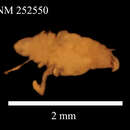en
names in breadcrumbs


“Antias dimorphis, new species
Synonyms: None.
Diagnosis: Frontal border of cephalon concave. First antenna with five articles, terminal article longest. Uropodal rami two, both as long as or longer than peduncle. Exopod about two times length of endopod. Lateral borders of pleotelson and body devoid of setae. Male with first peraeonal somite two times the length of second. Female with peraeonal somites subequal in length.
Additional descriptive notes: Mandibular palp triarticulate, maxilliped with two coupling hooks. Flagellum of second antenna with at least 19 articles.
Measurements: Holotype male 2.0 mm long, 0.5 mm wide. Gravid female allotype, 2.5 mm long, 0.75mm wide.
Type locality and types: Southern Chile, Islas Guaitecas, Puerto Melinka, 14 February 1949, St. M 52, tidal belt, rocks, stones and sand, rather exposed; holotype male, allotype gravid female, and three male paratypes.
Distribution: Known only from type locality.
Affinities: This species shows no marked affinities with other known Antias. The smooth and elongate body, concave frontal margin, and sexual dimorphism are enough to distinguish it from all others.”
(Menzies, Robert, 1962: 63)